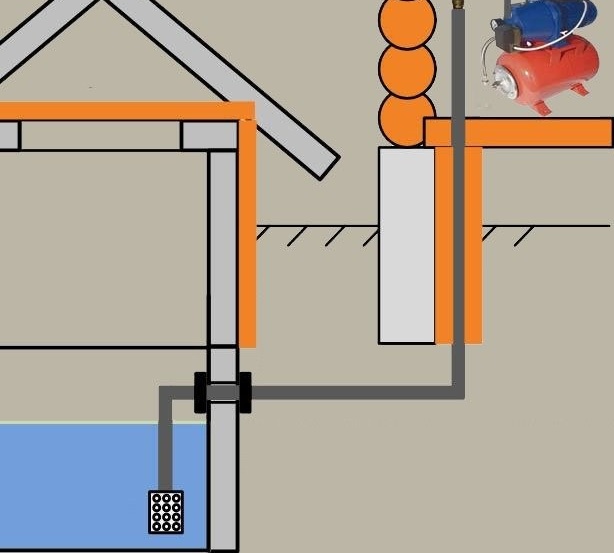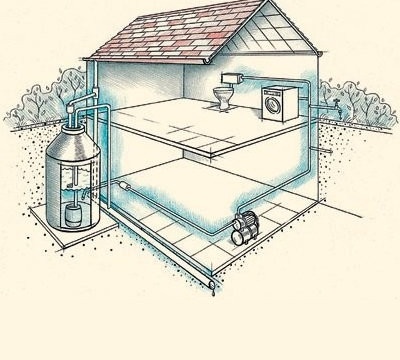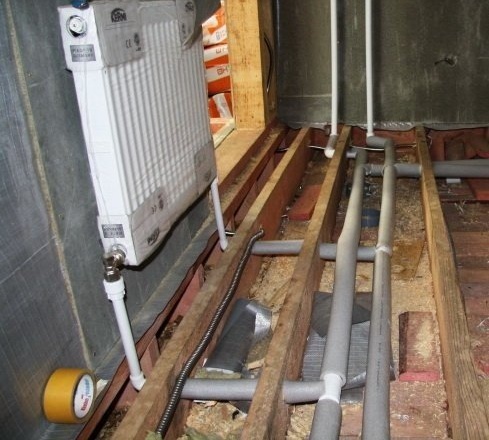Autonomous water supply for a private house: DIY tips
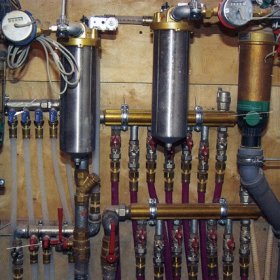
Plumbing in a private house is not a luxury, but the most pressing need. Disagree with this statement can only be one who has never had to carry endless buckets of water from a public column or the nearest well. If there is no possibility to connect to a centralized water supply, it remains to organize private house water supply do it yourself. Today we will provide some professional advice on creating an autonomous water supply system.
Content
How to create your own water supply?
Fortunately, the experience of organizing water supply to private buildings today is quite rich. A typical water supply scheme for a private house includes elements such as:
- source of water (well or well);
- a device for supplying water to the system (pump or pumping station);
- accumulator;
- system of water pipes, external and internal;
- necessary plumbing fixtures.
If the house plans to organize water heating for domestic needs, a boiler will also become part of the water supply scheme of a country house. Most often, these are dual-circuit models that separate the functions of heating a house and heating tap water. An alternative could be an electric storage water heater.
Read also our material on installing a water supply system in a private house:https://aquatech.tomathouse.com/en/santehnika/snaruzhj/vodoprovod-v-chastnom-dome-svoimi-rukami.html.
Where is better to take water?
Organization of autonomous water supply in a country house begins with the search for a suitable source of water. Usually, the estate owners have three options for solving the problem:
- well;
- well "on the sand";
- artesian well.
The well is the simplest and least expensive design, but there is not so much water in it, and its purity is in question. Pollution by meltwater, sewage that has penetrated into the ground, various debris and even the corpses of small animals - these problems are well known to well owners. It should be noted that it is still easier to clean a well than a well, which may also be contaminated.
The well "on the sand" allows you to get water from the aquifer, which lies relatively shallow - 10-30 meters from the surface. Water from such a well is produced using a submersible pump. The water from the well "onto the sand" usually comes in fairly good quality, but the source must be properly maintained to prevent siltation. Water from a sand well usually needs additional filtration.
Maximum excellent clean water can be obtained from an artesian well. This is the most expensive and time-consuming way to create a water source, because artesian water runs very deep. However, a pump for such a well is not required, and several houses, or even a whole settlement, can be provided with water at once.
Please note: It is imperative to make an analysis of water from an artesian well. Although it is usually very pure, it may show elevated levels of iron or other minerals. It is also worth remembering that artesian water is quite high hardness.
The lucky owners of the artesian source will have to deal with government agencies. Waters from deep horizons are classified as strategic reserves of the state, so the source must be registered with the appropriate institutions.
An interesting solution for the water supply system of a country house can be the Abyssinian well. The construction of an Abyssinian well is relatively inexpensive, work is carried out literally within a few hours, and you can install a compact Abyssinian well even in the basement of a private house.
How to deliver water to a house from a well or well?
For the owner of his own well, the most appropriate option for a water supply device in a private house will be to use a pumping station. This system consists of a centrifugal pump, a hydraulic accumulator, an electric motor, a pressure switch, etc. With the help of a pumping station, you can automatically turn on and off the pump so that there is always enough water in the hydraulic tank and it does not overflow.
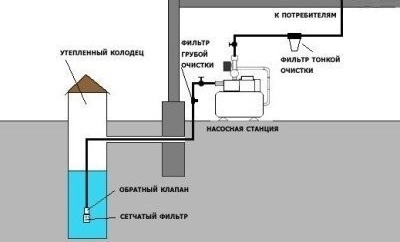
When organizing the water supply of a private house with water from a well, you can use a pumping station or a pump complete with a tank in which a float water level sensor is installed
You will learn about the device and the principle of operation of the accumulator in our next material:https://aquatech.tomathouse.com/en/vodosnab/document/gidroakkumulyator-dlya-vodosnabzheniya.html.
A correctly adjusted pump station allows you to get a sufficiently high pressure of water in the system so that you can use, for example, a hydromassage shower or other civilization benefits available to citizens.
For a pump or pump station, prepare a place in the house or build a separate room. The pipe through which water will flow is lowered into the well. The edge of the pipe, covered with a strainer, is placed approximately 30-40 cm from the bottom. A special pin is mounted in the concrete bottom of the well, to which a water pipe is attached to fix its position.
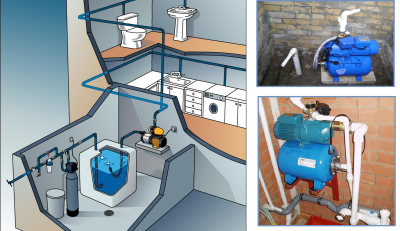
The pumping station can be successfully placed in the basement of a private house. In this case, noise from a working device will not disturb residents
Please note: The water pipe is laid in a trench to a depth that exceeds the level of freezing of the soil. So that in winter the water in the pipe does not freeze, you need to take care of the appropriate insulation of the external water supply.
When choosing a pumping station, you should focus on the characteristics of the well. A standard pumping station can lift water from a depth of nine meters to a height of 40 meters. However, if the well is located at a sufficiently large distance from the house, it would be more reasonable to use a centrifugal self-priming pump equipped with an external ejector.

The pump station allows you to organize autonomous water supply in a private house as efficiently as possible. At the same time, it is possible to provide the same good water pressure as in the city water supply
A check valve and a coarse filter must be placed in front of the pump. A fine filter is placed after the pumping station. Then set the pressure gauge and pressure switch. The pump station is connected to the control panel and to the water supply system of the house.
Advice! After installing the pumping station, it is necessary to establish work pressure switchto ensure the correct operation of the device.
Instead of the pumping station, you can use a submersible pump, the operation of which is controlled by a float sensor installed in the storage tank for water.
In the same way, the water supply system of a private house using water from a well is mounted.If the pump station will be installed in a separate warm room above the well, the installation procedure is approximately the same as when organizing the delivery of water from the well.

When installing a caisson above the well, it is necessary to dig a fairly spacious pit, concrete the bottom, install the caisson and fix it correctly in the ground
However, you can install a pumping station and directly above the well, in a special tank, which is called a caisson. To do this, you must:
- Dig a pipe to a depth of about 2.5 meters. The diameter of the pit should be twice the diameter of the caisson.
- Lay a layer of concrete at least 20 cm thick at the bottom.
- Install a caisson in the prepared pit.
- Trim the pipe so that it rises above the edge of the caisson by 50 cm.
- Dig a trench for the water pipe. The depth of the pipe - 1.8-2 m.
- Install a pump in the caisson and connect it to the well pipe.
- Pour the caisson along the contour with a layer of concrete of approximately 40 cm.
- After the concrete has dried, fill the remaining space with a sand-cement mixture, not reaching the top edge of the caisson about 50 cm.
- Cover the remaining space with soil.
- Install a pressure accumulator in the living room with a pressure switch, pressure gauge and other devices.
- Connect all the elements of the system, connect them to the power supply and to the internal water supply system.
See also our material with step-by-step instructions for installing, connecting and starting up the pumping station: https://aquatech.tomathouse.com/en/vodosnab/nasos/nasos-stancii/podklyuchenie-nasosnoj-stancii-k-skvazhine.html.
After this, it remains only to check the operability of all elements of the water supply system, to make sure that there are no leaks at the junction points, to eliminate the identified shortcomings and enjoy your new water supply, the characteristics of which can be even better than in centralized city systems.
